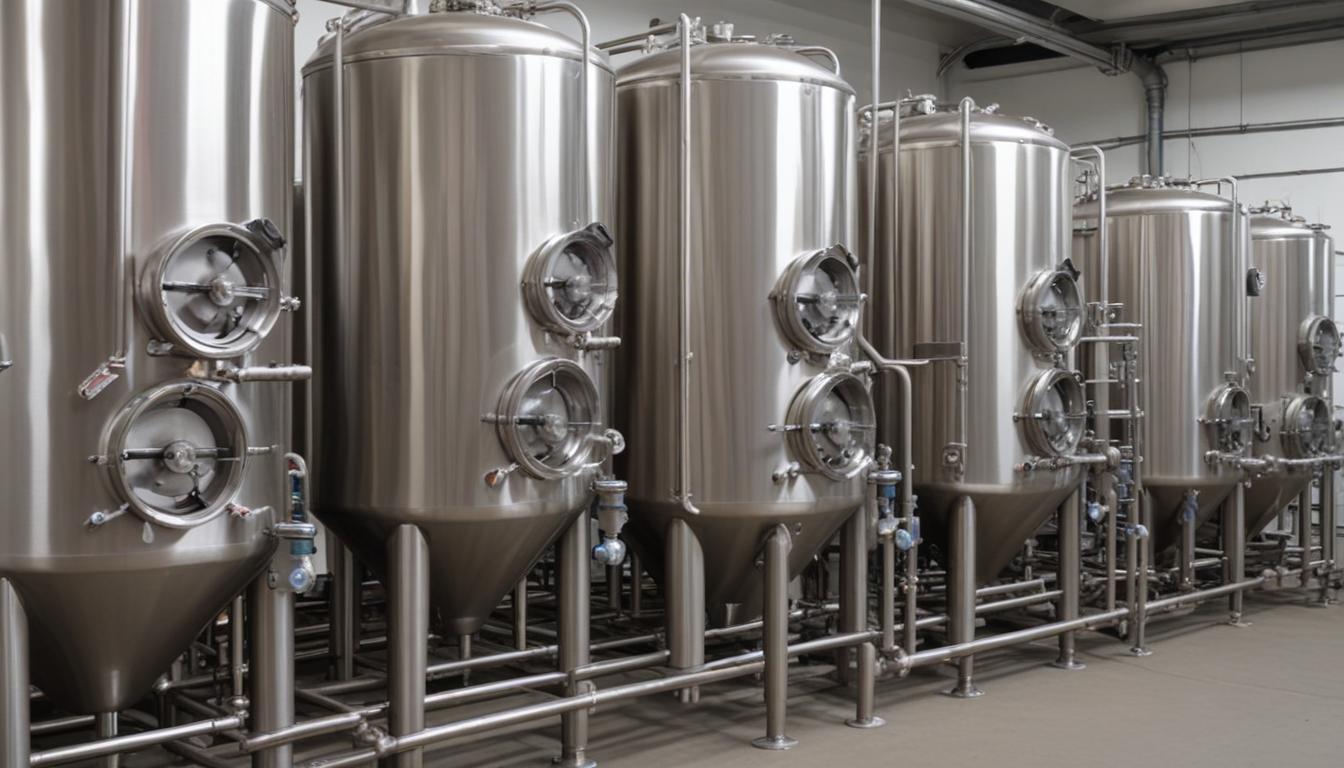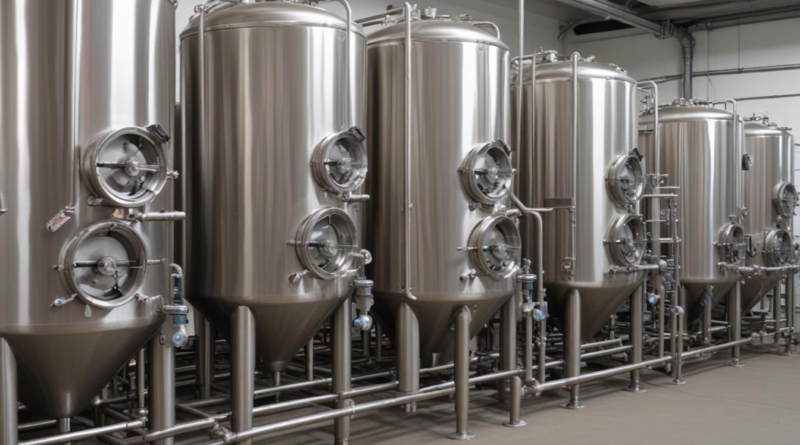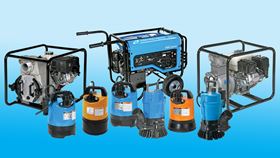pumps used in the brewing industry
In the brewing industry, selecting the appropriate brewing pumps is crucial for ensuring efficient and hygienic processing. Several types of pumps are commonly employed, each suited to specific applications within the brewing process.
Centrifugal Pumps
These are among the most widely used pumps in brewing due to their versatility and reliability. They operate by converting rotational kinetic energy, typically from an electric motor, into hydrodynamic energy of the fluid flow. Centrifugal pumps are ideal for transferring large volumes of liquid with low to moderate viscosity, making them suitable for tasks such as:
– Wort transfer
– Hot liquor tank circulation
– Fermenter agitations
Positive Displacement Pumps
These pumps deliver fluids at a constant flow rate, regardless of the pressure conditions. They are particularly useful in applications requiring precise dosing and handling of thicker fluids. The main types include:
- Gear Pumps: Utilize interlocking gears to move fluid, ideal for transferring wort and slurry.
- Piston Pumps: Suitable for high-pressure applications, such as carbon dioxide injection.
- Diaphragm Pumps: Excellent for hygienic applications where fluid contamination must be minimized.
Peristaltic Pumps
Operating by compressing a flexible tube to move fluid, peristaltic pumps are highly valued for their contamination-free process. They are particularly advantageous for:
– Pumping sterile liquids
– Handling aggressive cleaning agents during CIP (Clean-In-Place) procedures
Screw Pumps
These pumps use one or more screws to move fluid along the pump’s axis. They are known for their ability to handle viscous and shear-sensitive liquids with minimal degradation, making them suitable for:
– Moving fermenting beer without disturbing yeast
– Transferring syrupy wort
Gear-Free Rotary Pumps
Designed without traditional gear mechanisms, these pumps offer smoother flow and reduced maintenance. They are ideal for:
– Delicate transfers where maintaining fluid integrity is paramount
– Reducing mechanical wear in continuous brewing operations
The following table summarizes the primary types of pumps used in the brewing industry along with their key characteristics and typical applications:
| Pump Type | Key Characteristics | Typical Applications |
|---|---|---|
| Centrifugal | High flow rates, low to moderate viscosity | Wort transfer, hot liquor circulation, fermenter agitation |
| Positive Displacement | Constant flow rate, precise dosing | Dosing additives, carbon dioxide injection |
| Peristaltic | Contamination-free, flexible tubing | Sterile liquid transfer, CIP processes |
| Screw | Handles viscous fluids, low shear | Fermenting beer, syrupy wort transfer |
| Gear-Free Rotary | Smoother flow, reduced maintenance | Delicate liquid transfers, continuous operations |
Selecting the right pump type depends on various factors, including the specific stage of the brewing process, the physical properties of the fluids being handled, and the desired flow rates. Understanding the distinct advantages and applications of each pump type ensures optimal performance and longevity of the brewing equipment.
selection criteria for brewing pumps
When selecting the appropriate brewing pumps, several critical factors must be considered to ensure optimal performance and compatibility with the specific requirements of the brewing process. The following criteria are essential in making an informed decision:
- Fluid Characteristics: Understanding the physical properties of the fluid, including viscosity, temperature, and the presence of solids, is fundamental. High-viscosity liquids or those containing particulates may require specialized pumps like screw pumps or positive displacement pumps.
- Flow Rate Requirements: The required volume of fluid to be moved per unit time dictates the pump’s capacity. Pumps must be selected to handle the peak flow rates without compromising performance.
- Pressure Requirements: Different stages of the brewing process may require varying pressure levels. For instance, carbon dioxide injection necessitates high-pressure pumps such as piston pumps.
- Hygienic Standards: Compliance with hygiene regulations is paramount. Pumps that are easy to clean and sanitize, such as peristaltic pumps and diaphragm pumps, are preferred in environments where contamination must be minimized.
- Material Compatibility: The materials used in pump construction must be compatible with the fluid being handled to prevent corrosion and ensure longevity. Stainless steel is commonly used due to its durability and resistance to various brewing liquids.
- Energy Efficiency: Selecting energy-efficient pumps can lead to significant cost savings over time. Consider the pump’s power consumption relative to its performance capabilities.
- Maintenance and Reliability: Pumps should require minimal maintenance and exhibit high reliability to reduce downtime. Designs with fewer moving parts, such as gear-free rotary pumps, often offer greater reliability.
- Cost Considerations: Both the initial investment and ongoing operating costs must be evaluated. It is essential to balance budget constraints with the need for quality and performance.
- Space Constraints: The physical footprint of the pump should fit within the available space without hindering other equipment or processes.
- Control and Automation: Advanced control features and compatibility with automated systems can enhance operational efficiency and ease of integration into existing workflows.
To streamline the selection process, the following table outlines key selection criteria along with their considerations:
| Selection Criteria | Considerations |
|---|---|
| Fluid Characteristics | Viscosity, temperature, particulates |
| Flow Rate | Required volume per unit time, peak flow rates |
| Pressure Requirements | Operating pressure levels, pressure stability |
| Hygienic Standards | Ease of cleaning, compliance with sanitary regulations |
| Material Compatibility | Corrosion resistance, durability of materials |
| Energy Efficiency | Power consumption, operational costs |
| Maintenance and Reliability | Frequency of maintenance, likelihood of failures |
| Cost | Initial purchase price, total cost of ownership |
| Space Constraints | Physical size, installation requirements |
| Control and Automation | Integration with control systems, ease of operation |
Additionally, it is beneficial to evaluate the types of pumps available against these criteria to identify the most suitable options for specific applications within the brewing process. Factors such as ease of installation, availability of spare parts, and manufacturer support also play a significant role in the decision-making process. By meticulously assessing these selection criteria, brewers can ensure that their chosen pumps not only meet the immediate operational needs but also contribute to the long-term efficiency and success of the brewing operation.
maintenance and troubleshooting
Regular maintenance is essential to ensure the optimal performance and longevity of brewing pumps within the brewing industry. Implementing a comprehensive maintenance program not only minimizes downtime but also enhances the reliability and efficiency of the brewing process. Effective maintenance encompasses routine inspections, cleaning, lubrication, and timely replacement of worn components. Additionally, being adept at troubleshooting common issues is crucial for swift resolution and maintaining uninterrupted operations.
Routine Maintenance Practices
Adhering to a structured maintenance schedule helps in identifying potential issues before they escalate. The following practices are fundamental for maintaining different types of brewing pumps:
- Visual Inspections: Regularly check for signs of wear, leaks, and corrosion. Inspect pump seals, hoses, and connections to ensure they are intact and functioning correctly.
- Cleaning: Remove any residue or buildup within the pump and its components. Utilize appropriate cleaning agents that are compatible with the pump materials to prevent damage.
- Lubrication: Apply lubricants to moving parts as per the manufacturer’s recommendations. Proper lubrication reduces friction and wear, thereby extending the pump’s lifespan.
- Component Replacement: Replace worn or damaged parts, such as seals, bearings, and impellers, to maintain pump efficiency and prevent further deterioration.
- Calibration: Ensure that the pump operates within the specified parameters by regularly calibrating flow rate and pressure settings.
Troubleshooting Common Issues
Despite regular maintenance, brewing pumps may encounter operational challenges. Identifying and addressing these issues promptly is vital to maintain the brewing process’s continuity and quality. Common problems and their solutions include:
| Issue | Possible Causes | Troubleshooting Steps |
|---|---|---|
| Reduced Flow Rate |
|
|
| Excessive Noise |
|
|
| Overheating |
|
|
| Leakage |
|
|
Preventive Maintenance Strategies
Implementing preventive maintenance strategies can significantly reduce the likelihood of unexpected pump failures. Key strategies include:
- Scheduled Maintenance: Develop and adhere to a maintenance schedule based on the manufacturer’s recommendations and the pump’s usage patterns.
- Condition Monitoring: Utilize sensors and monitoring tools to track pump performance metrics such as vibration, temperature, and flow rates. Early detection of anomalies allows for timely intervention.
- Training and Documentation: Ensure that maintenance personnel are adequately trained in pump operation and troubleshooting techniques. Maintain detailed records of maintenance activities, repairs, and component replacements to inform future maintenance efforts.
- Inventory Management: Keep an inventory of critical spare parts to facilitate prompt repairs and minimize downtime during component failures.
Best Practices for Effective Maintenance
Adopting best practices enhances the effectiveness of maintenance efforts and prolongs the service life of brewing pumps. These practices include:
- Adherence to Manufacturer Guidelines: Follow the maintenance procedures and schedules recommended by the pump manufacturer to ensure proper care and handling.
- Regular Training: Continuously train maintenance staff on the latest pump technologies, maintenance techniques, and safety protocols.
- Use of Quality Parts: Utilize high-quality replacement parts and components to maintain the integrity and performance of the pump.
- Environment Control: Maintain a clean and controlled environment around the pump to prevent contamination and reduce the risk of external damage.
By implementing systematic maintenance and being proactive in troubleshooting, brewers can ensure that their brewing pumps operate efficiently and reliably, thereby supporting the overall brewing process and product quality.
advantages of different pump types
 Different pump types offer unique benefits tailored to specific applications within the brewing process. Understanding these advantages allows brewers to optimize their operations by selecting the most suitable pump for each task.
Different pump types offer unique benefits tailored to specific applications within the brewing process. Understanding these advantages allows brewers to optimize their operations by selecting the most suitable pump for each task.
Centrifugal Pumps
Centrifugal pumps are favored for their high flow rates and ability to handle low to moderate viscosity fluids efficiently. Their primary advantages include:
- Versatility: Suitable for a wide range of liquids, including wort, hot liquor, and fermenting beer.
- Energy Efficiency: Generally consume less energy for large volume transfers compared to other pump types.
- Simple Design: Fewer moving parts result in easier maintenance and lower operational costs.
- Continuous Operation: Ideal for processes that require a steady and uninterrupted flow of liquid.
Positive Displacement Pumps
These pumps excel in delivering precise flow rates, making them ideal for applications requiring accuracy and consistency. Key benefits include:
- Consistent Flow: Maintains a steady flow rate regardless of pressure changes, ensuring precise dosing of additives.
- High Pressure Capability: Capable of operating under high-pressure conditions, suitable for tasks like carbon dioxide injection.
- Handling Viscous Fluids: Efficiently moves thicker liquids without significant loss of performance.
- Self-Priming: Can handle fluids with varying viscosities and are less prone to cavitation.
Peristaltic Pumps
Peristaltic pumps are renowned for their ability to handle sterile and abrasive fluids without contamination. Their main advantages are:
- Hygienic Operation: The fluid only contacts the tubing, minimizing the risk of contamination and making them ideal for sterile liquid transfer.
- Ease of Cleaning: Simple to disassemble and clean, supporting effective CIP (Clean-In-Place) procedures.
- Flexibility: Can handle a wide range of fluid viscosities and are suitable for pumping aggressive cleaning agents.
- Leak-Free Operation: Reduced risk of leaks since the fluid is contained within the tubing.
Screw Pumps
Screw pumps are particularly advantageous for handling viscous and shear-sensitive liquids. Their notable benefits include:
- Low Shear Handling: Moves fluids gently, preserving the integrity of shear-sensitive components like yeast during beer fermentation.
- High Efficiency: Capable of maintaining consistent flow rates with minimal energy consumption.
- Durability: Robust construction allows for long-term operation with reduced maintenance requirements.
- Versatility: Effective in transferring syrupy wort and other thick liquids without clogging.
Gear-Free Rotary Pumps
These innovative pumps offer smooth and reliable performance with several distinct advantages:
- Smoother Flow: Eliminates the pulsations common in gear-based systems, ensuring a continuous and stable flow.
- Reduced Maintenance: Fewer mechanical components lead to lower wear and tear, minimizing downtime.
- Enhanced Reliability: Designed for continuous operation, making them ideal for high-demand brewing environments.
- Quiet Operation: Operates with minimal noise, contributing to a more comfortable working environment.
The following table highlights the primary advantages of each pump type, facilitating a clear comparison for decision-making:
| Pump Type | Key Advantages |
|---|---|
| Centrifugal |
|
| Positive Displacement |
|
| Peristaltic |
|
| Screw |
|
| Gear-Free Rotary |
|
By leveraging the distinct advantages of each brewing pump type, breweries can enhance their operational efficiency, maintain product quality, and ensure seamless integration within their production processes. Selecting the right pump not only addresses specific applications but also contributes to the overall sustainability and scalability of the brewing operation.
innovations and future trends
Advancements in brewing pump technology are continually shaping the future of the brewing industry, enhancing efficiency, sustainability, and overall process control. Emerging innovations focus on integrating digital technologies, improving energy efficiency, and utilizing advanced materials to meet the evolving demands of modern breweries. These trends not only optimize existing processes but also open new possibilities for automation and precision in brewing operations.
Digitalization and Smart Pump Systems
The integration of digital technologies into brewing pumps is revolutionizing how breweries manage and monitor their pumping systems. Smart pump technologies offer enhanced control, real-time monitoring, and data analytics capabilities, enabling brewers to optimize their processes more effectively.
- IoT Connectivity: Internet of Things (IoT) enables pumps to communicate with other equipment and central control systems, facilitating seamless data exchange and coordinated operations.
- Remote Monitoring and Control: Advanced sensors and connectivity allow operators to monitor pump performance remotely, adjusting settings and addressing issues without being physically present.
- Predictive Maintenance: Utilizing machine learning algorithms, smart pumps can predict potential failures by analyzing data trends, thereby minimizing unexpected downtime and maintenance costs.
- Enhanced Data Analytics: Real-time data collection and analysis provide valuable insights into pump performance, helping optimize flow rates, energy consumption, and overall system efficiency.
Energy Efficiency and Sustainability
As sustainability becomes a key priority in the brewing industry, innovations in pump technology are increasingly focused on reducing energy consumption and minimizing environmental impact.
- Variable Frequency Drives (VFDs): VFDs adjust the pump’s speed to match the required flow rate, significantly reducing energy usage compared to traditional fixed-speed pumps.
- High-Efficiency Motors: Advances in motor design enhance energy efficiency, lowering operational costs and reducing the carbon footprint of brewing operations.
- Regenerative Pump Systems: These systems recover and reuse energy generated during pump operation, further improving overall energy efficiency.
- Eco-Friendly Materials: The use of sustainable and recyclable materials in pump construction reduces environmental impact and aligns with green brewing practices.
Advanced Materials and Construction
Innovations in materials science are leading to the development of more durable and hygienic pump components, essential for maintaining the high standards required in the brewing industry.
- Corrosion-Resistant Alloys: The use of stainless steel and other corrosion-resistant materials extends the lifespan of pumps, particularly in environments with high acidity or aggressive cleaning agents.
- BPA-Free Plastics: Ensuring that materials do not leach harmful substances into the brewing process is critical for maintaining product quality and safety.
- Enhanced Seal Technologies: Improved seal designs prevent leaks and contamination, maintaining the integrity of the brewing process.
- Lightweight Composites: Advanced composite materials reduce the overall weight of pump components, simplifying installation and maintenance while maintaining structural integrity.
Automation and Integration
The push towards greater automation in brewing operations is driving the development of pump systems that can seamlessly integrate with other automated processes, ensuring consistency and precision.
- Automated Flow Control: Pumps equipped with automated flow control mechanisms can adjust flow rates dynamically based on real-time process requirements, enhancing consistency and reducing human error.
- Seamless Integration with ERP Systems: Integration with Enterprise Resource Planning (ERP) systems allows for comprehensive management of brewing operations, from ingredient handling to final distribution.
- Robust Communication Protocols: Advanced communication protocols ensure reliable data transfer between pumps and other automated systems, supporting coordinated and efficient operations.
- Self-Diagnostics: Automated diagnostic features identify and report issues within the pump system, enabling quicker resolution and maintaining uninterrupted brewing processes.
Future Trends in Brewing Pump Technology
The brewing industry is poised to benefit from several emerging trends that promise to further enhance the efficacy and sustainability of pumping systems.
| Trend | Description | Potential Impact |
|---|---|---|
| Artificial Intelligence Integration | AI-driven algorithms to optimize pump operations and predict maintenance needs. | Increased operational efficiency and reduced downtime through intelligent decision-making. |
| Modular Pump Designs | Flexible, modular pump systems that can be easily customized and scaled. | Enhanced adaptability to changing production needs and easier upgrades or expansions. |
| Wireless Communication | Adoption of wireless technologies for easier installation and maintenance. | Improved accessibility and reduced installation complexity, especially in retrofitting older systems. |
| Biotechnology Integration | Pumps designed to handle biological materials with greater precision and care. | Ensuring the integrity and quality of biologically sensitive brewing processes. |
| Enhanced Safety Features | Advanced safety mechanisms to protect operators and equipment. | Reduced risk of accidents and equipment damage, ensuring a safer working environment. |
Collaborative Innovations
Partnerships between pump manufacturers and technology providers are fostering collaborative innovations that drive the development of cutting-edge solutions tailored to the brewing industry’s specific needs.
- Custom Pump Solutions: Collaborative efforts lead to the creation of pump systems specifically designed for unique brewing processes, enhancing performance and reliability.
- Research and Development: Joint R&D initiatives focus on exploring new materials, technologies, and design methodologies to address emerging challenges in brewing.
- Knowledge Sharing: Industry partnerships facilitate the exchange of best practices and technological advancements, promoting continuous improvement across the sector.
By embracing these innovations and future trends, the brewing industry can achieve greater efficiency, sustainability, and product quality. The continuous evolution of brewing pump types and their applications ensures that breweries remain competitive and capable of meeting the dynamic demands of the market.




